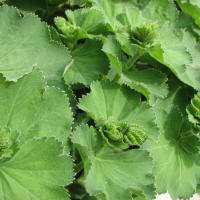Lady's mantle
Alchemilla vulgaris
Introduction:
Alchemilla vulgaris, commonly known as lady's mantle, is a perennial herbaceous plant belonging to the Rosaceae family. Native to Europe, Asia, and North Africa, lady's mantle is well-known for its distinctive foliage and delicate, chartreuse-yellow flowers. It has been cultivated for centuries for its ornamental, medicinal, and even folklore-associated uses.
Identification:
Appearance: Lady's mantle typically grows to a height of about 30-50 cm. The leaves are palmate, kidney-shaped, and have serrated edges. The soft, velvety texture of the leaves is often enhanced by water droplets, which collect on the surface and create a charming effect. The small, yellow-green flowers form dense clusters, and each individual flower has a unique, star-like appearance.
Distinctive Features:
- Leaves: Palmate, kidney-shaped, with serrated edges and a velvety texture.
- Flowers: Small, chartreuse-yellow, forming dense clusters with a star-like appearance.
Cultural Uses:
-
Ornamental Plant: Lady's mantle is popularly cultivated for its ornamental value. The unique foliage and chartreuse flowers make it a desirable addition to gardens and landscapes.
-
Cut Flower Arrangements: The fresh or dried flowers are often used in floral arrangements, adding a touch of elegance.
Medicinal Uses:
Lady's mantle has a history of traditional medicinal use, and various parts of the plant are believed to have therapeutic properties. Some traditional uses include:
-
Women's Health: The herb has been historically associated with women's health, and infusions have been used for menstrual issues and menopausal symptoms.
-
Wound Healing: The leaves were traditionally applied to wounds to promote healing.
Habitat and Distribution:
Lady's mantle prefers cool, temperate climates and is often found in meadows, woodland edges, and mountainous regions. It has also been widely cultivated in gardens and naturalized in various areas.
Cultivation Tips:
-
Soil and Sun: Lady's mantle thrives in well-drained soil with partial to full sunlight.
-
Watering: Provide regular watering, especially during dry periods, to keep the soil consistently moist.
-
Pruning: Trim spent flower stalks to encourage continued blooming and maintain a tidy appearance.
Caution: While lady's mantle is generally considered safe, pregnant or breastfeeding women should consult with healthcare professionals before using it for medicinal purposes.










